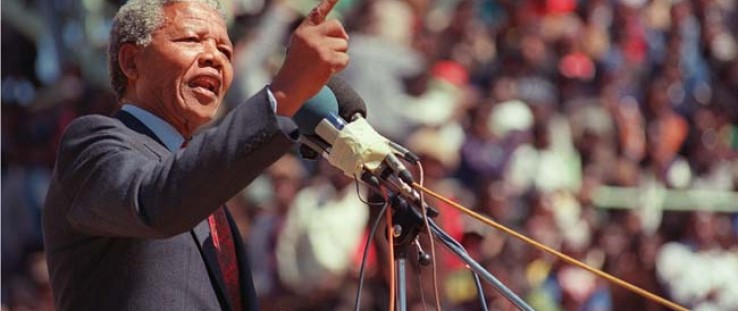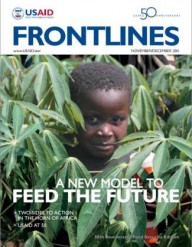 Anti-apartheid leader and African National Congress member Nelson Mandela speaks at a funeral for 12 people who died during township unrest in Soweto, South Africa, Sept. 20, 1990.
CREDIT: ALEXANDER JOE, AFP
Anti-apartheid leader and African National Congress member Nelson Mandela speaks at a funeral for 12 people who died during township unrest in Soweto, South Africa, Sept. 20, 1990.
CREDIT: ALEXANDER JOE, AFP
 Anti-apartheid leader and African National Congress member Nelson Mandela speaks at a funeral for 12 people who died during township unrest in Soweto, South Africa, Sept. 20, 1990.
CREDIT: ALEXANDER JOE, AFP
Anti-apartheid leader and African National Congress member Nelson Mandela speaks at a funeral for 12 people who died during township unrest in Soweto, South Africa, Sept. 20, 1990.
CREDIT: ALEXANDER JOE, AFP
As the Cold War was winding down in the 1980s, international attention turned to the apartheid regime in South Africa.
The United States passed the Comprehensive Anti-Apartheid Act of 1986, authorizing assistance to apartheid victims to become full participants in the political, social, economic, and intellectual life of South Africa. The Act further required that projects benefit legally disadvantaged communities and have community support and participation.
Prior to its enactment, USAID, with the support of the Congress, was already working on a program in South Africa, beginning with human rights programming which I designed as assistant general counsel for Africa.
U.S. policy was to help bring an end to apartheid and establish a nonracial, democratic government. In response to this policy and the Act, USAID/South Africa was responsible for financing projects that apartheid victims viewed as critical in promoting social, political, and economic change through peaceful means.
The mission enabled community consultation and ensured that the United States did not impose foreign-defined solutions to local problems. USAID created projects and activities to respond to the priorities of the black community and its leaders, maximized black participation and leadership, and ensured activities had a linkage to the general objectives of U.S. policy.
First-year funding for the program was $25 million, which was raised to $50 million the second year. The main project areas were community outreach and leadership development to redress the repression of black-led institutions; educational support and training to address the educational crisis in South Africa; black private enterprise development to combat the inhibiting effects of apartheid–induced discrimination in private enterprise; university grants to help create a new generation of economic and political leaders; human rights; legal assistance; labor union training; and health and nutrition.
There are many factors that made USAID/South Africa unique and a challenge to establish, including a political rather than an economic development objective. Because of the sensitive political situation with the South African Government, the embassy was initially a reluctant partner.
No funds or consultation could be provided to or through the government. This led to great suspicion and attempts to delegitimize our activities. The staff had to be kept smaller than would normally be required by the level of funding, challenging the mission to do more with less.
For the first year, the staff was limited to four officers, including the director, a program officer, a private sector officer, and a secretary. We were authorized to hire limited local staff. In order to make and manage a large number of grants with such a small team, we used an implementation mechanism by which the mission-funded projects were designed and presented by South Africans, essentially acting like a foundation.
The system worked well, but only because staff were willing to put in nights and weekends at the office. Growing demands led to modest staff increases in the second year. USAID had implementation concerns because of the lack of project management and development experience, corruption (sometimes encouraged by the South African Government to weaken leadership), and political disruptions. However, due to the care and vigilance of the USAID officers, program reviews showed a normal level of auditable issues.
The first three program guidelines?black priorities, black participation, and leadership and community consultation?all required a deep and meaningful relationship, as yet non-existent, with the anti-apartheid community. This was a major threshold to be overcome before any funds could be programmed.
Because the U.S. Government was very late in joining other governments in actively supporting the anti-apartheid forces, and the embassy only had one officer communicating with the black community, the mission started from scratch to build relationships.
Congress wanted us to commit $25 million in small grants during the first year, adding pressure to respond quickly and effectively.
We began by using my human rights contacts. Each day, the staff of three focused on creating relationships with the human rights, education, community organization, labor, and private sectors, keeping in mind our most important principle, which was to listen. Within three months, we felt that we had a grasp of the key leadership in the areas of program focus, but still needed to deepen relationships. Suspicion of USAID was palpable. We made it clear that the American people had, in effect, created a trust fund for the anti-apartheid forces and that funds would only be disbursed when we received clear guidance from their leadership. Only through dogged persistence and building one-on-one relationships were we able to win the confidence of community leaders.
We were constantly tested by these communities, but because we kept to our principles and proved responsive to their perceived needs rather than our own, we were able to overcome the obstacles. During the first year of the program we established a database of well over 1,000 community contacts.
There was a widespread, very dim view of U.S. policy. This was based on U.S. reluctance and lateness in engaging anti-apartheid forces, a perception that the Reagan administration opposed the Act, Assistant Secretary of State Chester Crocker’s view that Namibia needed to be tackled before South Africa, and a constant stream of rhetoric and criticism leveled against anti-apartheid forces from certain members of the Congress.
The English-language Citizen newspaper?favorable to the ruling National Party?published articles alleging that U.S. Government assistance was more threatening to South Africa’s self-determination than were sanctions, and that we were financing terrorist and leftist organizations.
There was a great deal of concern that the South African Government would directly curtail the work of USAID, which it ultimately did by investigating organizations that we were funding, including detaining leaders without charges. We created a legal framework for assisting organizations under attack.
For many years, anti-apartheid forces were under the influence of the Black Consciousness Movement (BCM), which believed in education and creating black institutional capacity as the means for change, and included the bulk of South African intellectuals. The left-leaning African National Congress?a banned organization at the time?created the anti-government United Democratic Front (UDF) political party as its in-country surrogate. The UDF was clearly the most powerful internal source for change but had little implementation capacity, and USAID does not fund political parties.
How the new mission would deal with the dichotomy between the individuals involved with the main political force, the UDF, and the intellectual and institutional capacity of the older BCM leadership would be a key to our success in implementing an effective program. In short, most of our resources were directed to projects created by individuals associated with the BCM, however, we worked carefully to recruit prominent, capable UDF leaders for advisory boards and for our major educational program initiatives. This attention to an underlying political fact helped the mission create a strong foundation for later growth.
The early work of USAID/South Africa successfully laid the groundwork for the much larger programs that followed. Key accomplishments were reversing the deeply held belief of the South African anti-apartheid leadership that the United States was opposed to regime change; quickly identifying and cultivating the current and future political, economic, and social leadership of a nonracial South Africa; putting in place a program framework that was perceived by anti-apartheid leadership and the Congress as responsive to the needs of the struggle; and, most importantly, effectively implementing the will of the American people as expressed by the Act.









Comment
Make a general inquiry or suggest an improvement.